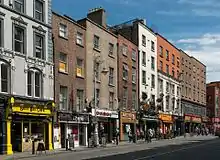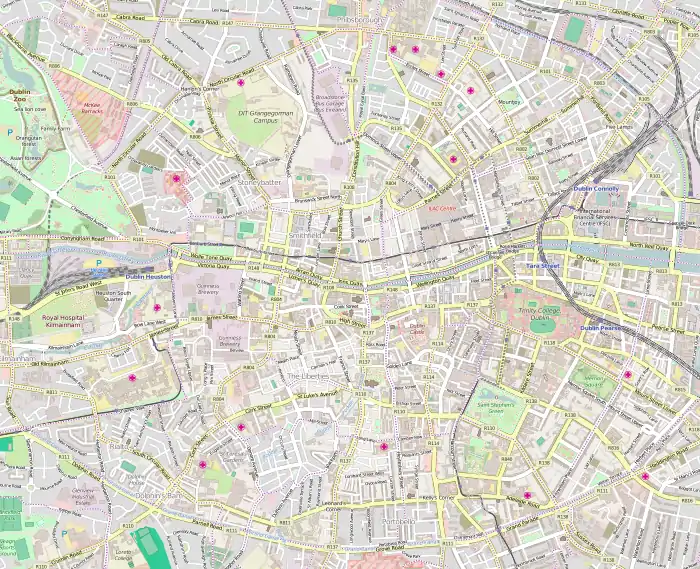Dame Street
Dame Street (/ˈdeɪm/; Irish: Sráid an Dáma) is a large thoroughfare in Dublin, Ireland.
 | |
 | |
| Native name | Sráid an Dáma (Irish) |
|---|---|
| Namesake | A medieval dam on the River Poddle |
| Length | 300 m (1,000 ft) |
| Width | 20 metres (66 ft) |
| Postal code | D02 |
| Coordinates | 53°20′39″N 6°15′53″W |
| west end | Cork Hill, outside City Hall |
| east end | College Green |
| Other | |
| Known for | banks, restaurants |
History
.jpg.webp)
The street takes its name from a dam built across the River Poddle to provide water power for milling.[1] It appears later as Dammastrete and Damask-street. There was a medieval church of St. Mary del Dam which was demolished in the seventeenth century. Sir Maurice Eustace, Lord Chancellor of Ireland 1660–1665, built his townhouse, Damask, on the site.
Location
During the day, the street is busy, due to its central location in the city. It is a five-minute walk to the shopping area of Grafton Street and ten minutes from O'Connell Street. The Temple Bar area of the city is located directly north of the street. Daly's Club was founded in the 1750s at numbers 1-3 Dame Street and remained there until 1791, when it moved to College Green.[2]
Architecture
The former Central Bank of Ireland headquarters, now known as Central Plaza, on Dame Street was built in 1975. It was initially higher than planning permission allowed, though this was retrospectively rectified.[3] The new building was built on a parcel of land on which was a collection of Victorian and Georgian buildings including the Commercial Buildings. The Commerical Buildings dated from 1796, and were associated with the Ouzel Galley Society. This building also featured a paved courtyard which served as a pedestrian shortcut between Merchant's Arch and the Ha'penny Bridge beyond. Initially planners wanted the facade the building retained, but it was discarded and eventually a replica was constructed in the scheme. Commenting on the scheme in September 1972, Architects' Journal stated that the proposed building was "an exercise in how to do the greatest urban damage".[4] The Bank left the premises in March 2017, and moved to North Wall Quay.[5] In comparison, Northern Bank, retained the Italianate headquarters of the Hibernian Bank both the exterior and interior, with redevelopment taking place behind the streetscape.[6]
The street features a modern square, Barnardos Square in front of Dublin Castle and to the side of City Hall. The site had been occupied by a row of shops, one of which was the birthplace of the square's namesake, Thomas John Barnardo.[7] Before its redevelopment, the site had been cleared of the Georgian terrace of buildings which were demolished in the mid-1970s as part of a road widening development. One of the surviving buildings from the block is the headquarters of the Sick and Indigent Roomkeepers' Society. In the 1980s there was a proposal to create a park on the site.[8]
Occupy protests

The Occupy Dame Street protest began in October 2011 directly outside the then headquarters of the Central Bank of Ireland, as part of the global Occupy movement, and lasted until March 2012.[9][10][11]
References
Notes
- Casey 2005, p. 414.
- T. H. S. Escott, Club Makers and Club Members (1913), pp. 329–333
- McDonald, Frank (1985). The destruction of Dublin. Dublin: Gill and Macmillan. pp. 165–175. ISBN 0-7171-1386-8. OCLC 60079186.
- McDonald 1985, p. 166-170.
- Brennan, Cianan (2017-01-17). "Central Bank completes sale of its Dublin HQ for €67 million". TheJournal.ie. Retrieved 2021-01-11.
- McDonald 1985, p. 118.
- Finlay, Fergus (23 September 2014). "Thomas Barnardo changed the way we think about children". Irish Examiner. Retrieved 27 January 2021.
- McDonald 1985, p. 318-319.
- "'Occupy Dame Street' protest in Dublin". RTÉ News. Raidió Teilifís Éireann. 9 October 2011. Retrieved 9 October 2011.
- "Occupy Dame Street protest enters third night". RTÉ News. Raidió Teilifís Éireann. 10 October 2011. Retrieved 10 October 2011.
- Nihill, Cían (5 November 2011). "'Occupy Dame Street' campaign prepared for long haul". The Irish Times. Irish Times Trust. Retrieved 5 November 2011.
Sources
- Casey, Christine (2005). Dublin: The City Within the Grand and Royal Canals and the Circular Road with the Phoenix Park. Yale University Press. ISBN 978-0-30010-923-8.CS1 maint: ref=harv (link)
- McDonald, Frank (1985). The Destruction of Dublin. Gill and MacMillan. ISBN 0-7171-1386-8.CS1 maint: ref=harv (link)
| Wikimedia Commons has media related to Dame Street, Dublin. |